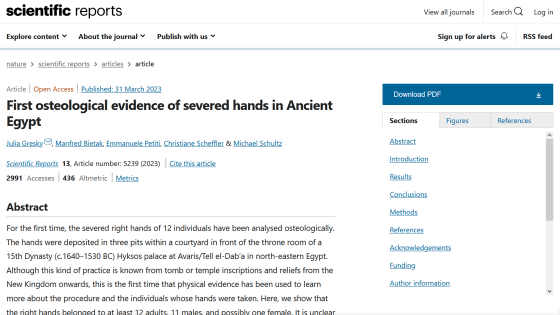'Massive hands' found in ancient Egyptian palace garden may have been severed for victory ceremony

First osteological evidence of severed hands in Ancient Egypt | Scientific Reports
https://doi.org/10.1038/s41598-023-32165-8

Palace pits with severed hands studied in ancient Egyptian site
https://phys.org/news/2023-04-palace-pits-severed-ancient-egyptian.html
A Pit of Severed Hands Could Be The Remains of a Grisly Ancient Egyptian Ceremony : ScienceAlert
https://www.sciencealert.com/a-pit-of-severed-hands-could-be-the-remains-of-a-grisly-ancient-egyptian-ceremony
The 15th dynasty of ancient Egypt is the time when the Hyksos, which are said to have roots in Asia, took control, and it has long been said that ``the Hyksos were a group of different ethnic groups that invaded Egypt.'' However, recent research has shown that the Hyksos were not aliens who suddenly invaded ancient Egypt, but were likely a group of immigrants who had settled inside ancient Egypt for several generations.
In the 15th dynasty palace ruins in Tel al-Dabaa in northeastern Egypt, more than 10 'cut right hands' have been discovered from three holes dug in the courtyard facing the throne room. A team of German and Austrian researchers conducted an osteological analysis of this amputated hand.
The image below shows part of the hand actually discovered from the ruins. The research team states that these right hands were cut from 11 men and 1 woman, a total of 12 people, but since multiple incomplete hands and fingers were also found, up to It is possible that there were 18 hands.

In an analysis by Julia Gresky, a paleopathologist at the German Archaeological Institute, and colleagues, the bones that connect the hand to the forearm, called
Also, both hands had their fingers spread out, so it seems that their hands were still soft when they were cut and placed in the hole. Rigor mortis , in which the body of the dead person stiffens, generally begins 6 to 8 hours after death in the case of the hand, so the research team found that the hand was cut immediately after the owner died or was alive. , it was likely placed in the pit within 24 to 48 hours after rigor mortis had ended. ``After removing the attached forearm, the hand was placed palm side down on the ground with the fingers spread wide,'' the research team said.

In ancient Egypt, the practice of amputating the right hand is not seen prior to the 15th Dynasty, but in
Also, the focus of this research was whether the amputation of the right hand was a kind of punishment or a ritual to celebrate military victory. The research team said, ``The amputation site, treatment, and place where the hand was placed contradicts the hypothesis that the motive for amputating the hand was the execution of punishment,'' the ritual in which the hand was amputated at the palace. I showed the view that it was done as part of.

Related Posts:
in Science, Posted by log1h_ik







